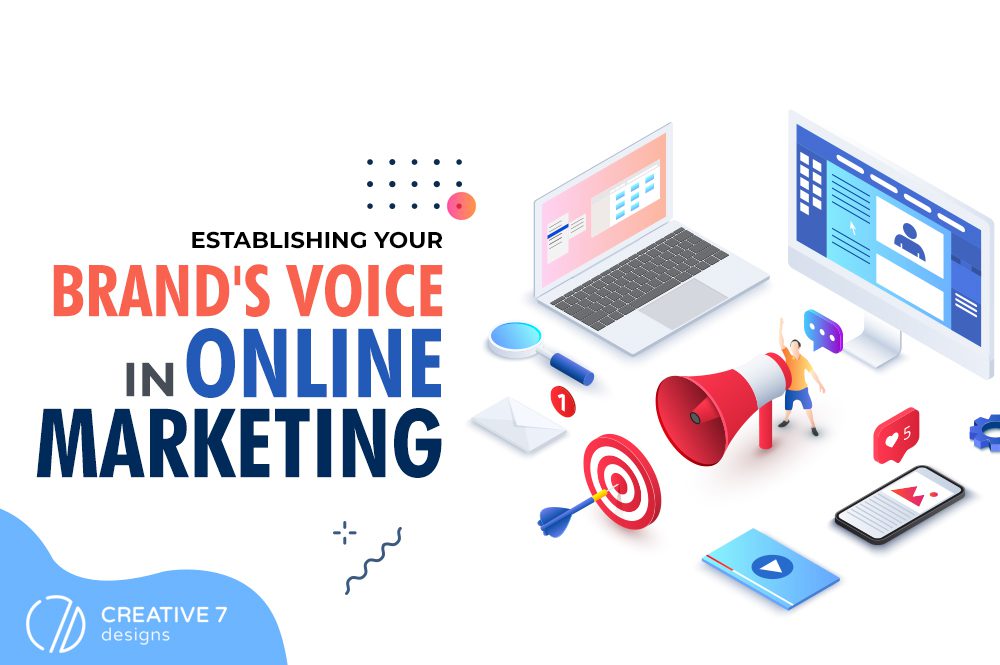Overview: Brand voice is the personality your brand takes on in its online communications. Learn how can you establish yours!
If your logo didn’t appear with your content, could your target audience identify it as coming from your brand? In the battle of brands, you want yours to stand out amongst the competitors and leave a lasting impact on your audience. That’s why it’s so important to establish your brand’s voice in the digitized marketing world.
When people hear the word brand, they often think about visual identity. The visual identity — including the name of your company and your logo — is representative of your brand; however, there’s another element that gets overlooked: voice and tone!
Related Reading: How your website design can affect human emotion?
What is Brand Voice?
Brand voice is how you talk to your customers. Your brand voice is directed to your target audience and reflects your style. Just as you talk to your partners, colleagues, and friends in specific ways, you can also make choices about the way you communicate with your customer base.
Customers invest more in brands when they feel an emotional bond than they do when brands dish out uninspired and disconnected content. It sounds cliche, but it’s true: It’s not what you say; it’s how you say it.
The importance of a brand’s voice shouldn’t be underestimated. Imagine you go to a dinner party, chatting with your acquaintances. Since you’re a guest, you’ll keep yourself limited to a particular group of people. However, one person stands out because they’re great at storytelling with distinctive flair and style. The flow of their words, their language choices, and the vibes they spread all over combine to make for a memorable experience.
When you think of that person later, after the party, it’s likely that you’ll strongly associate them with their manner of speaking. Their communication style — their voice — will leave a lasting impression. The same thing happens when consumers absorb communications relayed by brands.
From blog posts and advertisements to emails and social media platforms, a brand’s voice must stay consistent, to ensure that customers (and potential customers) have a strong sense of the company’s identity.
Now back to that dinner night speaker. We described a dynamic storyteller, which might be the type of voice you choose for your brand in marketing materials. Or you could choose any number of other possible voices. If you could envision your brand as a person, what personality traits would they take on? What phrases, and what stylistic and syntactic choices, would you like your brand to use consistently?
Once you answer these questions, a rough structure of your brand voice is already built. All these combine to create your brand voice, and this personality is applied to everywhere your brand speaks, be it a newsletter, social media post, or press release.
How Do You Develop a Brand Voice?
To develop your brand voice, the first step is determining your core brand identity and highlighting the aspects of your business that help it stand out from competitors. Once you’ve settled on a brand voice, maintaining consistency in your content creation efforts is essential.
Related Reading: Learn the top secrets to successful content creation
Seek input from within your company: For effective communication, you’ll want to establish a brand voice that incorporates the values and personality traits that your company’s personnel strongly identify with. It’s a great idea to cast a wide net, inviting everyone from ownership, managers, and employees of all types to provide input about what they consider the company’s style to be. Consult everyone, from PR to sales experts, from the marketing team to customer service.
Imagine your brand as a human: Back to the party-goer analogy: If you could magically turn your brand into a human, what would that human sound like? Bold, cautious, fun, formal, reflective, poetic? Voice is about personality and the traits that distinguish one person’s communication style from another person’s.
It might make sense to pattern the voice after one of the “head honchos” of the company. In a Forbes article on brand voice, Scott Baradell, the founder of PR firm Idea Grove, had this to say: “When we lead brand personality discovery exercises with clients, we sometimes look to the personality of the company’s CEO or most successful salespeople as a starting point. Then we translate that into a voice.”
Present your company’s mission and vision: To reach your potential prospect, you must voice your goals, mission, and vision. When people find your company, through any means, they want to know what you’re trying to achieve, what you see as the future of your brand, and how you’re willing to get there. Your mission defines the personality you want your voice to present.
Define your values and culture: Be it a conversation at a social gathering or a public statement by your brand, values play a distinct role in the way people and businesses are perceived. Define what you believe in and what qualities you see in your brand (and the qualities you’d like others to associate the brand with). When reflected in your public communications, your values and culture can help you reach your target audience.
Consider your competitors: The hard pill to swallow is that there’s almost no solution to every problem, so when your brand steps into a competitive market, focus more on what your brand offers than what others don’t. Anything that ranks you higher and causes you to stand out from your competitors should be emphasized in your voice. Let your customers know you’re confident in what you’re doing and that you stand by your products or services.
Identify your target audience: When you attempt to sell yourself to everyone, you end up selling yourself to no one. Focus on the audience you want, and ask yourself the question: Is this audience receiving my message?
What problems does your audience have that you can help solve? Are they interested in your brand and its core values? Consider your existing audience and why your brand appeals to them. Once you’ve figured that out, expand on thouse findings to refine your brand voice and reach your target audience.
Be consistent with your tone: Your audience should have an idea of what to expect from your brand voice, so you’ll want to keep it consistent. If you’re being funny on one social media platform and gravely serious on the other, it could cause all kinds of confusion. Don’t let your brand voice slip while you’re establishing it!
Related Reading: Build trust, and deliver consistency with your brand tone
In Summary:
When you’re establishing your brand voice, draw from within your company, its people, and the audiences you’re looking to target. Everyone who encounters your brand will make their own assessments of your voice, communication style, and tone. But what really matters is your confidence in the excellence of the product/service you’re offering and how successfully you’re communicating it.
Are you stuck in a rut in your branding and marketing journey? Creative 7 Designs is here to help you! Reach out to us today!







